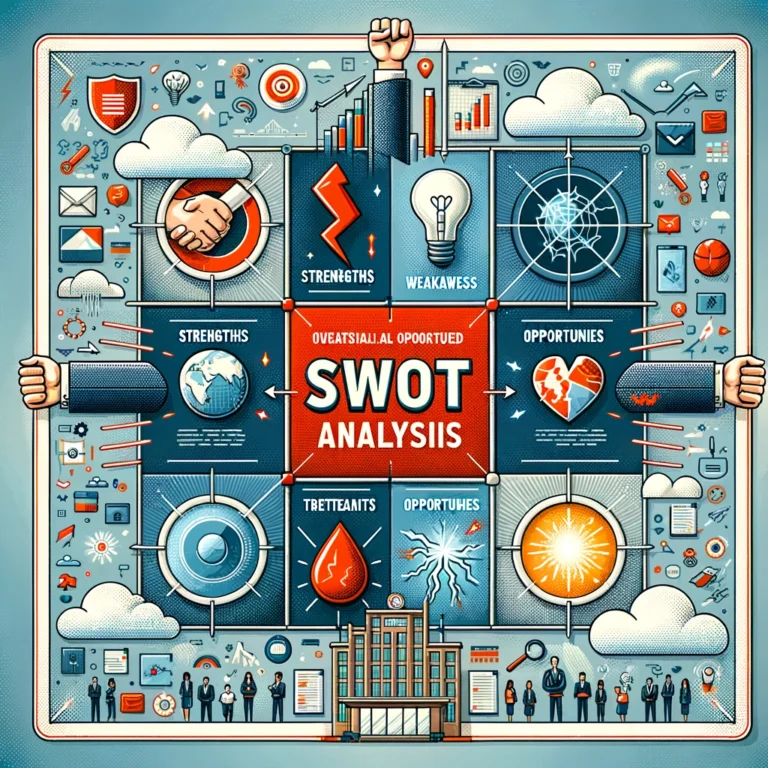SWOT analysis aims to identify the key internal strengths & weaknesses and external opportunities & threats, seen as important to achieving an objective.
The analysis of the internal strengths & weaknesses helps business owners determine their current market position, which is crucial to know before planning and implementing SMART objectives. A useful tool for:
- competitor analysis;
- assessing opportunities;
- risk assessment;
- reviewing corporate strategy;
- strategic planning.

Examples of strengths
- Products X is market leader in terms of sales.
- Customers are loyal to the brand.
Examples of weaknesses
- Workers are striking demanding higher wages.
- Machinery is obsolete, lowering production output.
A SWOT (Strengths, Weaknesses, Opportunities, and Threats) analysis is a strategic planning tool used to understand a company’s internal strengths and weaknesses, as well as its external opportunities and threats. This tool is invaluable for businesses in assessing their competitive position and developing strategies for growth, sustainability, and competitive advantage. Through the lens of SWOT, businesses can critically evaluate their operations and environment to make informed decisions. This comprehensive analysis delves into the SWOT analysis framework, offering detailed explanations and industry examples to provide IB Business & Management students with insights into its application in real-world business scenarios.
Strengths
Definition: Strengths are internal attributes and resources that support a successful outcome. They are what the company does well or possesses that is superior to competitors.
Examples of Strengths:
- Product X is the Market Leader: A company like Apple with its iPhone enjoys a strong market position because of its innovative technology and brand loyalty.
- Brand Loyalty: Coca-Cola benefits from high brand loyalty, which is a significant strength. This loyalty comes from years of effective marketing and brand management.
Weaknesses
Definition: Weaknesses are internal factors that might hinder the achievement of an objective. These are areas where the business may be lacking or performs poorly compared to competitors.
Examples of Weaknesses:
- Worker Strikes Demanding Higher Wages: Companies like Amazon have faced worker strikes over wage and working condition disputes, highlighting potential weaknesses in employee relations.
- Obsolete Machinery: Manufacturers such as certain textile companies might struggle with obsolete machinery, impacting their production efficiency and output quality.
Opportunities
Definition: Opportunities are external factors that the organization could exploit to its advantage. These are trends, changes, or needs in the external environment that, if leveraged, could provide competitive advantage or growth.
Examples of Opportunities:
- Emerging Markets: For companies like Netflix, emerging markets represent a significant opportunity for expansion beyond saturated domestic markets.
- Sustainability Trends: Businesses such as Patagonia leverage sustainability as an opportunity, responding to increasing consumer demand for environmentally friendly products.
Threats
Definition: Threats are external challenges that could cause trouble for the business or project. These could stem from various sources like economic downturns, increased competition, or changes in regulatory landscapes.
Examples of Threats:
- Intense Competition: In the fast-food industry, brands like McDonald’s face threats from rising competitors offering healthier options or employing aggressive marketing strategies.
- Regulatory Changes: Pharmaceutical companies often face threats from changes in healthcare policies and regulations that might affect market access or product pricing.
Application of SWOT Analysis in Strategic Planning
Competitor Analysis: Businesses can use SWOT to understand their competitive position relative to key competitors, identifying areas for improvement or differentiation.
Assessing Opportunities: By identifying external opportunities, businesses can strategize to capitalize on these trends, aligning their internal strengths to market needs.
Risk Assessment: Understanding weaknesses and external threats allows businesses to develop contingency plans, mitigating risks that could derail strategic objectives.
Reviewing Corporate Strategy: Regular SWOT analysis helps businesses reassess their strategies in light of changing internal capabilities and external environments, ensuring they remain aligned with long-term goals.
Strategic Planning: SWOT analysis informs the development of strategic plans by highlighting where the company should invest resources to exploit opportunities and counter threats, leveraging its strengths and addressing weaknesses.
Conclusion
A SWOT analysis is a versatile tool that enables businesses to scrutinize their internal and external environments systematically. By understanding strengths, weaknesses, opportunities, and threats, companies like Apple, Coca-Cola, Netflix, Patagonia, and McDonald’s can devise strategies that leverage their unique capabilities and market positions. For IB Business & Management students, mastering SWOT analysis offers profound insights into strategic planning and decision-making processes, preparing them to address the complexities of the business world effectively.


